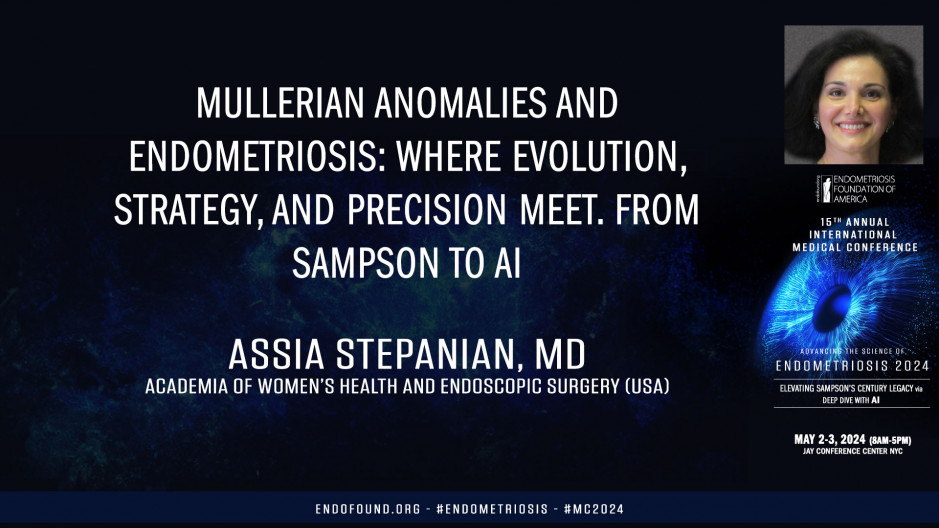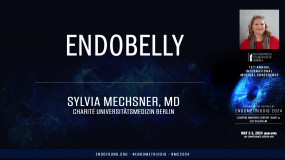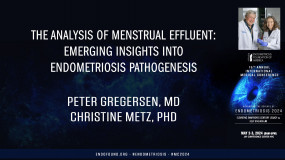International Medical Conference
Endometriosis 2024:
Elevating Sampson’s Century Legacy via
Deep Dive with AI
For the benefit of Endometriosis Foundation of America (EndoFound)
May 2-3, 2024 - JAY CENTER (Paris Room) - NYC
I have learned so much in my lifetime and also not only medicine, but I think life in general. And congratulations to this endeavor of endometrial foundation of endometriosis, foundation of America with all the work that is done to bring the awareness of the disease and also the studies together and such good people together. So the lecture is actually called Malian anomalies and endometriosis. And truthfully, this is where the evolution, strategy and precision can actually meet incredibly today. We'll travel between them. Lemme see, it doesn't click clicks. Now, between the artificial intelligence Simpsons theory, we will look into how to have the higher precision of surgery potentially, and we will try to look at the techniques of the surgeries that can be applied in cases where the endometriosis and malformations come together. My site in Atlanta participates in contracted research with AbbVie and it has no effect with this presentation.
So 6.7% of women altogether experience the MULIAN anomalies, extra genital anomalies in these women's as seen in 74% of cases, predominantly urinary. Of course, endometriosis has been observed in 56% of women with mulian anomalies. Several classifications exist. Three that I'd like to present here are ESGE classification where each particular defect is marked for communication purposes. The A SRM classification, which is highly used in the United States, and then Leila Damien's classification, the purpose of which is clinical morphological aspects. It was first done in 1991 and then updated in 2014, and it's my privilege to be part of it as well. In this classification. The classes are made by the symptoms by actual specific defects and the particular surgery and management related to those is streamlined and offered. And endometriosis can be seen in all Ian anomalies. Actually 20% of women with MRM RKH with visibly non-functional rudiments can experience endometriosis.
But obstructive anomalies are of course more associated with endometriosis, especially as you can see on the slide, a hundred percent cervical vaginal aplasia cases. So why don't we think about the Samsung theory here, and of course there are multiple aspects to it, but let's think about it. There is a retrograde blood flow. What comes in that menstrual blood? One of the things that was just mentioned a moment ago was the heme molecules and iron, which was very nice for me to hear in this presentation. So the study was done by Leila, Damian, and by our team to look at various studies in systematic review to identify the role of the retrograde menstrual flow and specifically iron. So ferritin concentration in the peritoneal fluid was found to be significantly higher in patients with endometriosis as compared with women in a control group. So obviously the menstruation goes on, erythrocytes are introduced through the microphages depending on what is the reason for that inflammation, heightened inflammation or just normal inflammation.
But there is a destruction of this erythrocytes production of heme molecules and then iron. But what was so interesting to see is that heme and iron together have inflammatory properties and they form reactive oxygen species with known to US effects. On those further thinking, there was a discovery of the role of oxidative stress on fer ptosis, not quite apoptosis in the pathogenic pathogenesis of endometriosis progression. The experimental model was formed as a result of the studies. It was proposed that the first defect of endometriosis is anomalous or abnormal ectopic endometrium. This endometrium was characterized by resistance to the ptosis, a process on iron dependent non clearly apoptotic programmed cell death. Yes. Okay, so iron, we addressed that. What about the stem cells? Incredible presentation done just before mine, so we would not go deeply into that. It was interesting to find in this study however, that there was an increased expression of CD 17 and other proto-oncogenes in endometrioid tissue as compared to the utopic endometrium in the same women.
Thinking further, that MRA genes responsible for proliferation and angiogenesis was studied in women, in whose case there was a recurrence of the disease. And it was noticed that in women, in whose case there is a recurrence, the expression of these genes specifically in the multipotent chemo stromal cells was higher. Okay, alright, menstrual flow is there, but what about fetuses? There is no significant menstrual flow. Newborn potentially yes, with the estrogen of the mothers, but not at the time of the fetal development as we think. And the meiotic implant in female fetuses were observed between 18 and 25 weeks of gestation and actually almost with the same rate as it is in the general population, 10 out of 101 fetuses had endometriosis on autopsy. So let's think why there is a connection that has to occur with the Ute development in crossing area of the meso nephro duct and gonadal ridges because there is an endometrium that develops and also there is a myometrium that develops.
Maybe that's why when we see people with adenomyosis and non-functioning uterine horns, we can see both. But utopic and ectopic endometrium derive from the primordial germ cells that go to the gonadal regions. So essentially at this gonadal regions and accumulation comes both the endometrium and the myometrium together. Let's move to surgery for a moment because we need to treat these people as well, and in the obstructive anomalies we have to create an obstruction, especially if somebody is interested in preserving the uterus and if it's possible to do that. In order to do this, we need to think of the neo vagina creation because in women, in whose case there is a cervical aplasia or vaginal cervical aplasia, we have to create the channel. So the best way to look at it is through this procedural formation of the neo vagina creation using the peritoneum. And Layla Adam, Damian has five techniques that has been offered in this regard.
We'll start with the first technique. If I can click on this, yes. And you can see here that there is a most mobile aspect of the peritoneum identified. There is an incision that will be made and you'll see it in the movie in a moment. There is an introduction of this particular probe into the perineum, seeing it through the laparoscopic view incision of the peritoneum here, suturing of the peritoneum and perineum together, probing enough, adequate patency, then tampon, and that's the top of the vagina, the apex. And there is a nice support as you can see present. So let's view that with them in surgery.
Let's see if it stops again.
Hopefully I can show you the surgery, otherwise I can talk about it. Okay, it moved on. Remember we spoke about the malformations and we said
That in malformations we have to think about the other conditions. Right here you will see a structure, and this is a pelvic kidney.
There is a slowing down if we do it this
Way, my dear. There is a pelvic kidney in this. I have one patient,
I had one patient in whose case there was an incredible association of the position of
The pelvic kidney in their vagina. So the pelvic kidney was at 12 centimeters. If it's at 12 centimeters from the perineum, where are you going to create a vagina?
And any technique can actually be potentially injurious in this case. So the
Ureters are observed, all the structures are observed, and we're going to move now to the formation
To the identification of the most prominent aspect of the vagina and then external view, which is normal in this ladies with Mr RKH. As you can see here, the probe is placed. We can make an incision which will be at the most prominent aspect of the dimple, most visible one. And be careful here because some people had the dilation that was performed before. And if it was performed before in a wrong place, then we can get into the rectum. Here's an introduction in two seconds. Peritoneum is right there. It's right at the level of external structures vaginally. In a second we will enter the peritoneum. This is a probe that you can see. There's only simply one layer of the peritoneum over it. The entry is done, the excision, the incision is going to be extended so that the peritoneum can be approximated with the perineum.
Be careful here From the standpoint of the surrounding structures, obviously orientation of the instrument is quite critical. Further, the stitches are placed and when the stitches are placed, don't include too much of the tissue that is under the vaginal dimple mucosa or under the peritoneum simply because it's going to be fibrotic. And then the vaginal length is going to be somewhat limited. This will be followed by examination or by the surgeon's finger placement of the, you can see the laparoscopic view and then by the surgeon's finger. And then we'll put right here and then we'll place the tampon in the vagina. We can see the patency absolutely is preserved. And then the right is laparoscopic, laparoscopic view here. Okay, so after the placement of the temple, and we will be proceeding with the placement of the stitch epically. Obviously folic catheter is in place here.
I'd like to mention that this is not a laparoscopic laparoscopic davidov technique concluded the separation at certain higher level of the peritoneum, which was overlying the bladder and therefore there was a two-step approach as it relates to peritoneum. And peritoneum was entered. Here we do not do that. We just approximate the top of the apex with approximation around the bladder per string stage goes on, fibrous streaks are attached here. Somebody who is afraid to do this, just that sigmoid colon, it's fine. We can stay just lateral to that at the per recal gutter. And then same is done on the opposite side. The purse string stitch is placed and the incision and the apex of the vagina is formed with the presence of the apical support in this vagina. If people are interested in formation of the transplant uterine transplant, it can be done after that.
Shala has done several cases of the uterine transplant. This is how it looks. This is the top of the vagina, that's the view. So always checking things around. And then we move to the next slide. This is the laparoscopic, purely laparoscopic technique. The same things are done. As you can see on the left side. The mucosa is now presented laparoscopically and attached to the peritoneum. Knowing several techniques is quite important because situations can be different In this patient's case, the pelvic kidney is located very close, so we cannot really be very cavalier in laparoscopic approach, but then we need to be safe in the vaginal approach. And so the provisionary stitches will be placed into the vagina and the surgery will be completed. Vaginally success is very, very nice for that. It's very safe to perform this procedure. The blood loss is absolutely minimal and the surgery results in immediate formation of the vagina.
The epithelium becomes completely epi with vaginal squam epithelium in three months. But it was interesting to see that this starts actually in the first week moving to the precision which actually has been declared by the White House as an important aspect in our management of patients. We are going to the AI enabled surgical planning and navigation in this study, which now has the patent as well. What was interesting is that we used the MRI slices and tion and Leila. Damian did that. We use them MRI slices, but not the three millimeter slices. Actually one millimeter slices. And there were three perpendicular planes that was studied and it allowed for higher precision to identify what is happening preoperatively, but also to see why is that what we are taught in surgery? Why is that that it works? Why is that? When we make incision in certain planes, we are in a vascular plane and we did not know before that de nire fascia has very well-defined two layers.
And this is why when we do the surgery for the sacrocolpopexy or when we do the surgery here we are in a vascular plane because we are between the two fascial planes. So just with the ai, it's interesting to look at what we already know and how do we know that this is interesting too. So let's say that there is a complex pelvis with the use of this model in which there is one millimeter slices. We can actually, with more precision, identify the surrounding structure and also the color coding of them obviously is presented. And look, there was an endometriosis of severity here. We can apply that to endometriosis. And it is applied to endometriosis often. But also having this visualization is quite helpful in people with anomalies as well. Three dimensional model allows navigation prior to surgery and grade educational tool. Moving back to endometriosis now, well, we've talked about presence of adenomyosis in 50% of cases when there is non-function, functional rudimentary horn, can we do the M RT H surgery?
Can we do this creation of surgery with the peritoneum in patients with endometriosis? Yes, we can. If it's a severe endometriosis, it can be gently excised. If there is an endometriosis which involves mild lesions, it can be especially laser excised, right? At that same time, bulky rudiments always need to be removed. Adenomyosis will be present in those rudiments at some point in time. And just as a beginning of the surgery, I'd like to show you how careful we need to be if we are thinking about the formation of the neo vagina. If you can see how close are we staying with those structures? Preserving the, preserving them peritoneum as much as possible. So those environments are going to be removed and the surgery on formation of the neo vagina immediately followed. Speaking about fibrosis, also enjoyed listening to your lecture. Thank you. We did the study of direct mass spectrometry at some point in time precisely for that question.
If there is a fibrosis, what is happening there? How much of endometriosis is actually present and why is it important? Certain lipids have the predisposition towards cell proliferation, cell migration, resistance to apoptosis, reduced immune response as well. And what's so interesting is that the direct mass spectrometry can actually be done right at the patient's table. Note that in three to six minutes you can have a result with good sensitivity and specificity about whether or not that tissue is involved with endometriosis. It is costly as everything that is new, but it's possible. And the good things that are costly but possible find their way. In class two of malformations, remember I said we already know how to create the vagina, but the principle here basically will be to laparoscopically identify the position, take the peritoneum down, then find where is that cervix. The moment you find the cervix identified here with the green arrows, you are in the right place.
And then the endo cervix can be attached to the vaginal dimple mucosa. Even if it's a little bit low, it'll stretch. It'll stay in place. And then the cervix needs to be protected Here, there is that approximation of the dimple to the endo cervical tissue, more complex case would be okay if there is no cervix, what do we do then? Then we need to form the cervix in somebody who is interested. The way to do it with the retrograde hysteroscopy, the uru is entered, pushes down vaginally already the channel is formed. So we can see that point in the uterus. Remember that the hysteroscopy also has light. So by the light you can see what is darker, what is lighter, what's the most prominent part, and then entry vaginally along that enlightened point. And then again, the approximation of the mucosa with the endo cervical aspect.
And finally, uterine horns, uterine horns, obstructed or not, is subject to excision simply because there is going to be pathology there, whether it's going to be endometriosis or extended adenomyosis. Pathology can be there in the future. So our job, before we bring the patient to the ora, and whenever they even start the symptoms or the pathology is identified as it was said in the first lecture, is to prevent this problem to prevent endometriomas of this side. So if we can do something to help the young girls before they need to be operated on, and please, let's not operate on the teenage girls. They need to play soccer, they need to play whatever they do, play violin. And let's include the imagination concerning this young people who are definitely interested in their own future and the future of their families. Let's all do it together because we truly can achieve it all. Thank you.










